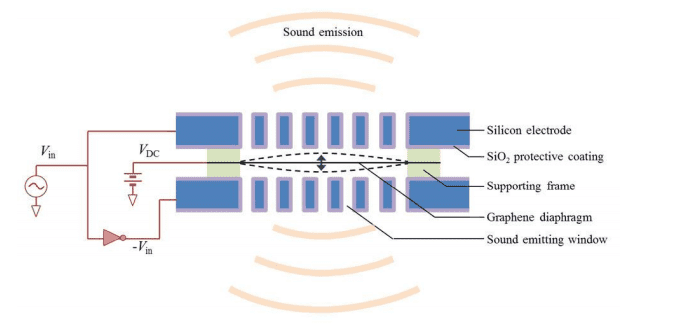I feel like a broken record – graphene is awesome at this, graphene is awesome at that… graphene is just awesome! A few months ago, we were telling you about the first graphene ear buds, which were really promising, but researchers still had a lot of work to make them commercially viable. Well, they’ve turned it up a notch, and designed the first graphene speakers.
The classical design for speakers includes a diaphragm that creates pressure waves in air by mechanically vibrating. The human audible range is approximately 20 to 20,000 Hz, although there is considerable variation between individuals.
“For human audibility, an ideal speaker or earphone should generate a constant sound pressure level from 20 Hz to 20 kHz, i.e. it should have a flat frequency response,” say Qin Zhou and Alex Zettl who are both at the University of California, Berkeley.
Today, they unveiled the world’s first graphene speaker. The earphone-sized speaker has just a few layers of graphene which act as the diaphragm. In case you’re not familiar with this wonder material, you really should. Graphene can be described as a one-atom thick layer of graphite (just Carbon atoms). According to lab tests, graphene promises to revolutionize everything from transistors and radios to superconductivity and particle physics.
This new speaker is fairly simple. It consists of a graphene diaphragm sandwiched between a couple of electrodes that create an electrical field. When the field oscillates, this causes the graphene to vibrate, thus generating the sound. What’s spectacular about it is the performance.
“The graphene speaker, with almost no specialized acoustic design, performs comparably to a high quality commercial headset,” says Zhou and Zettl.
This is owed exclusively to the spectacular properties of the graphene.
“It is electrically conducting, has extremely small mass density, and can be configured to have very small effective spring constant,” say Zhou and Zettl. And, of course, it’s also very strong.
The thin graphene filter which acts as a diaphragm is only 30 nm thick and 5mm in diameter, and even without any optimization or specialized design, is comparable to a conventional Sennheiser MX-400 earphone with promising results.
“Even without optimization, the speaker is able to produce excellent frequency response across the whole audible region (20 Hz~20 KHz), comparable or superior to performance of conventional-design commercial counterparts,” they say.
Ref: http://arxiv.org/abs/1303.2391: Electrostatic Graphene Loudspeaker



